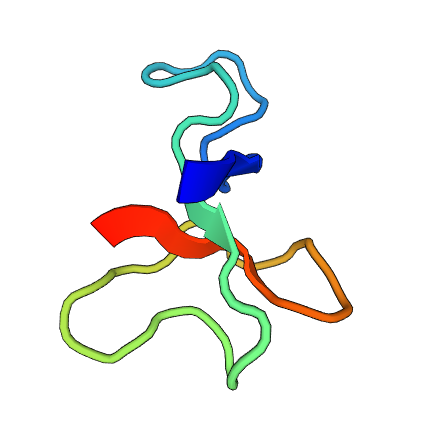| BcIII | |||||||
|---|---|---|---|---|---|---|---|
 Schematic diagram of the three-dimensional structure of BcIII Schematic diagram of the three-dimensional structure of BcIII | |||||||
| Identifiers | |||||||
| Organism | Bunodosoma caissarum | ||||||
| Symbol | N/A | ||||||
| UniProt | Q7M425 | ||||||
| |||||||
BcIII is a polypeptide sea anemone neurotoxin isolated from Bunodosoma caissarum. It targets the site 3 of voltage-gated sodium channels, thus mainly prolonging the inactivation time course of the channel.
Sources
BcIII can be isolated from the venom of the sea anemone Bunodosoma caissarum.
Chemistry
BcIII belongs to Type 1 sea anemone neurotoxins, which target the α-subunits of voltage-gated sodium channels (Nav1.x). It has 48 amino acids and a molecular mass of 4.976 atomic mass units. The secondary structure of BcIII consists of 4.0% α-helixes, 43.4% β-strands, 21.3% β-turns and 31.3% is unordered. The three-dimensional structure of BcIII can be found on SWISS-MODEL.
| G | V | A | C | R | C | D | S | D | G | P | T | S | R | G | N | T | L | T | G | T | L | W | L | T | - | G | G | C | P | S | G | W | H | N | C | R | G | S | G | P | F | I | G | Y | C | C | K | K |
Figure 1: The amino acid sequence of BcIII.
Target
BcIII binds to voltage-gated sodium channels on site 3, which is the extracellular loop connecting the segments S3 and S4 (the voltage sensor segment) of domain IV. BcIII has the biggest effect on Nav1.1 and Nav1.5 (Table 1). However, the affinity of BCIII to these sodium channels is relatively low in comparison with other toxins in the same family such as ATX-II and AFT-II.
Table 1: The affinity of BcIII to different sodium channels based on EC50 data.
| Sodium Channels Subtypes | EC50 (nM) |
|---|---|
| Nav1.1 | Estimated 300 |
| Nav1.2 | 1449 ± 216 |
| Nav1.3 | 1458 ± 129 |
| Nav1.4 | 821 ± 144 |
| Nav1.5 | 307 ± 33 |
| Nav1.6 | Estimated 900 |
Mode of action
BcIII binds to site 3 of voltage-gated sodium channels during the closed state. Therefore, it prolongs the inactivation time course. The channel remains longer in the open state before inactivating, leading to an increase in the peak amplitude of the sodium current
Moreover, BcIII acts in a voltage-dependent manner. At saturating concentrations, the rate of unbinding from receptor sites is positively correlated to the amplitude and duration of the membrane depolarization. As a result, the destabilizing effect of BcIII on sodium channels is reversible.
BcIII shows no affinity to the open state of sodium channels and has no significant effect on activation kinetics.
Toxicity
The LD50 of BcIII in mice is 600 μg/kg.
References
- ^ Oliveira, J.S., et al., BcIV, a new paralyzing peptide obtained from the venom of the sea anemone Bunodosoma caissarum. A comparison with the Na+ channel toxin BcIII. Biochim Biophys Acta, 2006. 1764(10): p. 1592-600.
- ^ Malpezzi, E.L., et al., Characterization of peptides in sea anemone venom collected by a novel procedure. Toxicon, 1993. 31(7): p. 853-64.
- Wanke, E., et al., Actions of sea anemone type 1 neurotoxins on voltage-gated sodium channel isoforms. Toxicon, 2009. 54(8): p. 1102-11.
- ^ Oliveira, J.S., et al., Binding specificity of sea anemone toxins to Nav 1.1-1.6 sodium channels: unexpected contributions from differences in the IV/S3-S4 outer loop. J Biol Chem, 2004. 279(32): p. 33323-35.
- ^ Salceda, E., et al., The sea anemone Bunodosoma caissarum toxin BcIII modulates the sodium current kinetics of rat dorsal root ganglia neurons and is displaced in a voltage-dependent manner. Peptides, 2010. 31(3): p. 412-8.
External links
- BcIII on NCBI
- Q7M425: BcIII on UniProt
- 3D Structure of BcIII based on SWISS-MODEL.